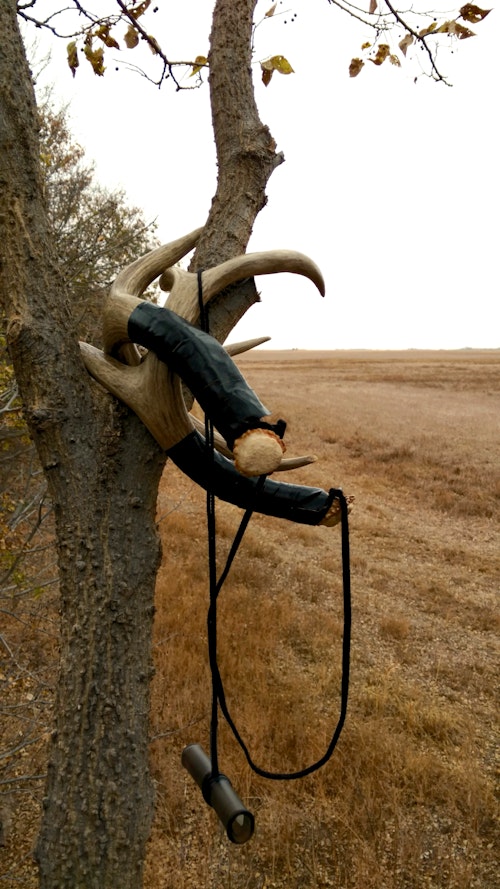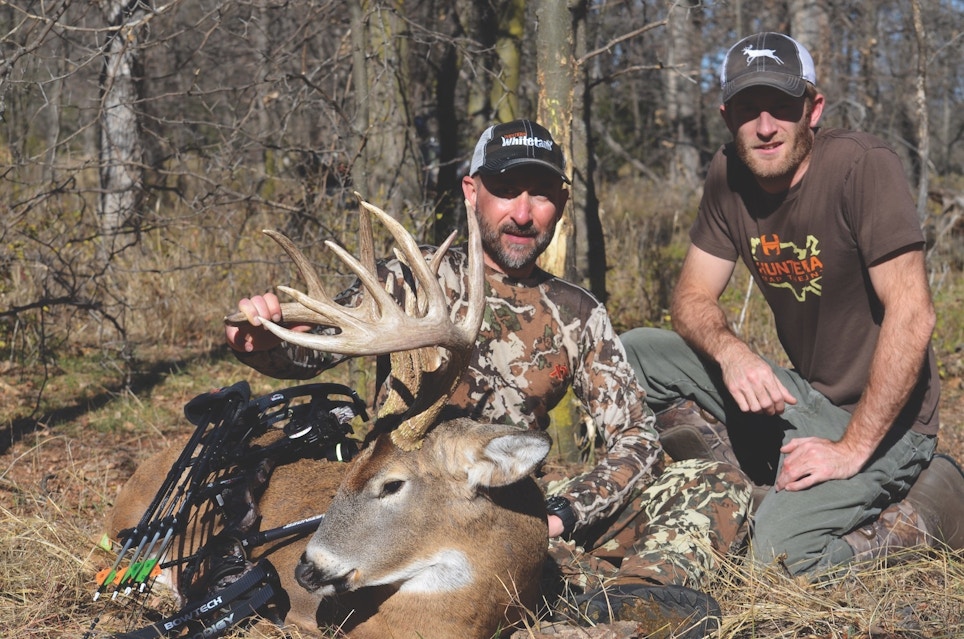Twenty feet up a tree, I peered out over a well-used rub and scrape line. I was hoping to see — and arrow — a Kansas buck-of-a-lifetime. However, all I saw was frost slowly building on the limbs of my bow, arrow and broadhead. It was my last of five days in Kansas chasing whitetail deer with Heartland Pride Outfitters in north-central Kansas. As morning faded, I could already taste the bitter tag soup about to be served. The lull in activity gave me time to reflect on my first Kansas archery rut hunt. Here’s how my adventure unfolded.
Day 1: Getting Started
On Monday morning, an hour before sunrise, I walked along a creek bank with my guide Cody Kuck, owner of Heartland Pride Outfitters. After a ¼-mile walk in the dark, Cody pointed into the darkness. “Right there is your ground blind," he says."Do you see it?” I did. Although all I really saw was darkness, and the outline of tree branches. Cody wished me good luck and headed back to his truck. I blindly crossed the creek (really a ditch), found the ground blind and set up all my gear for a day-long sit.
As dawn approached I could make out two deer at the nearby corn pile on a field edge. They were both does. I waited anxiously to see my first Kansas buck stroll in to check the estrous state of the does, but it never happened.
When the sun finally brightened the landscape, I glassed up another doe at the set. From my set-up, she was on the opposite side of the field. I sat all day only to see one more doe just outside of the blind in the late evening hours. Here it was the heart of the rut, and no bucks in sight.
Day 2: Don’t Be Shy!
On Tuesday morning, I climbed into a treestand about 300 yards south of the ground blind I had sat the previous day. Again, knowing it was the rut and anything could happen at any time, I was prepared to sit all day in hopes of catching a love-stricken buck passing beneath my stand. Less than an hour into my sit, I glassed a young buck out in the field. I decided to test my calling abilities and sounded a few grunts toward the buck. The buck responded immediately and headed my direction. All the while, I was hoping that the young buck would become a decoy for a larger buck in the area, but my hopes were never realized. The buck continued toward me and stopped about 60 yards away. Not wanting to educate the young buck, I quit calling and it eventually moved off.
Late in the morning, I caught a glimpse of a shooter buck cruising behind me about 150 yards away. I grunted toward the buck, but I could not coax it to my location. As evening approached, I caught movement behind me once again. I turned to look, but only saw a few white flags. Minutes later, the same deer ran my direction and into the field in front of me. Three does. I thought there had to be a buck in pursuit, but one never showed. As darkness neared, a lone doe came from left to right, passing underneath my stand at 20 yards. Again, no rut-crazed buck followed.
Day 3: All Broken Up
On Wednesday morning, a winter storm hit. Luckily, I was sitting in a hard-sided Darkwoods blind, which protected me from most of the effects of the 30 to 40 mph winds that preceded the heart of the storm. In the pre-dawn light, I made out a small 6-point buck across the river, nibbling from a feeder filled with nutritious protein. Later, another buck appeared, but it was too far away for a shot opportunity. I raised my Leupold binos to glass the buck. It looked like a borderline shooter, perhaps 135 inches.
After another hour, it finally happened: A shooter buck was making its way to the blind. As the buck neared, I was able to see both of the buck’s G-2s were broken at the main beam. I did not want to waste my tag on a broken-up buck. My heart sank! Later in the morning, an up-and-coming buck showed up. The buck was a solid 8-pointer with small kicker points on both G-2s. I could see the makings of a great Kansas trophy. After a small yearling doe fed across the river, I decided to call it a day. I was cold to the core and was feeling a little deflated.

Day 4: He Smelled Me!
Having the previous afternoon off reinvigorated my enthusiasm. Thursday morning was unexpectedly calm, with just a hint of wind. Early in the morning, a couple of small bucks showed up back at the feeder where I sat the previous morning. At midday I caught movement through thick understory, toward a feeder. A big buck appeared, but disappeared into the thick trees on the other side of the feeder just as quickly.
Frantically, I tried a grunt then a snort-wheeze. The buck would have none of it and flagged into the distance. I contacted Cody to let him know I had seen a shooter buck, but it left in a hurry. We had already planned to move to a new stand that afternoon because the wind was supposed to switch directions around 2 p.m.
We decided to stay on the same small property, but get into a treestand overlooking a scrape and rub line. I climbed into the stand around 1 p.m. Just minutes later a small buck passed by, followed by a doe, then another small buck moving in the opposite direction. By then the wind had picked up and was directly in my face. An hour or so into my sit, I could hear a deer stomping its hoof, but I could not see it.
At first, I thought the sound was coming from in front of me, but when the wind died down I realized it was coming from behind me. I cautiously turned to look over my left shoulder. As I did, I saw the 11-pointer I had already seen in video and trail-camera images. The buck had come in from downwind, winded me and was none too impressed with my presence. As I stood up, hoping for some miracle, the buck flagged and was gone.
I was dejected, but finished out the remainder of the day on stand. I saw no more deer.
Day 5: I Could Taste Tag Soup
Friday was my last day of this five-day hunt. About an hour before dark, I climbed into the treestand I sat the previous afternoon. Although the giant 11-pointer made me frustrated the day before, we were hopeful that love would bring the buck back my way.
About 30 minutes after sunrise, the up-and-coming buck I saw a couple of days before appeared along the fence line of the neighboring property. It merely glanced over the fence — perhaps looking for a doe and not seeing any — then went right back to the field it came from. An hour later through the thick river bottom, I could make out the white antlers of a buck in a winter wheat field about 200 yards in front of me. I desperately put together a string of grunts, but to no avail. I sat back down as disappointment set in. It was 10 a.m., and now all I could see was frost building on everything around me.
The 11th Hour
Just as I swallowed my pride and accepted I would be eating tag soup for dinner, it happened. I caught movement directly in front of me. Through the trees of the river bottom, a glimpse of white — antlers!
The buck approached, then turned to my left. My heart sank when I realized it may proceed to the feeder I’d sat at the last couple of days. Just as quickly, the buck turned and came directly to me. It stopped about 20 yards away from my stand and grunted once. Then the buck turned and moved to my left, perfect for a right-handed shooter.
Hidden by the branches of the tree in front of me, I drew my Bowtech and settled in for a shot. The buck stopped underneath my stand at just 6 yards! The buck was quartering toward me. I waited for as long as I could, but the buck did not move and didn’t look like it had intentions to. I knew I could make the almost-straight shot, so I released the arrow. The Easton Hexx, tipped with a 100-grain Wac’Em broadhead, made a complete pass-through. I watched the buck perish just 40 yards away.

Never Give Up!
During my five-day hunt, I spent more than 50 hours on stand, sitting all day, every day — minus the one afternoon I took off. The rut activity I experienced was minimal but, then again, I heard many hunters across Kansas were experiencing similar less-than-normal rut activity. The strong winter storm that moved through mid-week definitely hampered deer movement. Friday morning was cold, but the wind had subsided. It was a perfect morning for deer hunting. As fate would have it, it was the best day and it happened. I was ecstatic to be headed home with an 11th hour buck that grossed a score of 166 inches.
Bonus: Calling Deer
Thinking back, I can’t help but wonder if my calling actually led to my success. When the buck I eventually shot passed in front of me in the winter wheat field, I let out a series of grunts. First, I sounded a couple of buck grunts. Second, I let out two or three longer tending grunts. I lastly followed with a few more buck grunts. Even though it was almost an hour later, the buck showed up directly below me and grunted once in my direction, which makes me wonder about the encounter.
I believe the buck was cruising the field for does, either found none or thwarted off another buck or two, then headed in my direction thinking another buck was encroaching on his territory.
In either case, here are a few thoughts on communicating with deer during the rut:
- Ask fellow hunters how they use calls to communicate with deer.
- Research calling techniques online to see what others are saying about deer calling strategies.
- Watch TV shows of similar hunts during the rut where calling is used as a hunting method.
After you have compiled your data, come up with a game plan for different real-world scenarios. For example, if you encounter a subordinate buck, use the following series: grunt, doe bleat, tending grunt. If you encounter a dominant buck, use the following series: grunt, grunt, snort-wheeze.
Be cautious not to educate deer, especially bucks. But don’t be afraid to use your deer calls during the rut.







